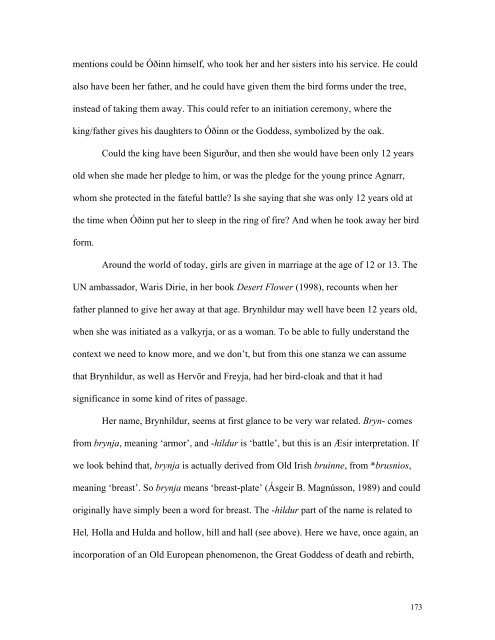You also want an ePaper? Increase the reach of your titles
YUMPU automatically turns print PDFs into web optimized ePapers that Google loves.
mentions could be Óðinn himself, who took her <strong>and</strong> her sisters into his service. He could<br />
also have been her father, <strong>and</strong> he could have given them the bird forms under the tree,<br />
instead <strong>of</strong> taking them away. This could refer to an initiation ceremony, where the<br />
king/father gives his daughters to Óðinn or the Goddess, symbolized by the oak.<br />
Could the king have been Sigurður, <strong>and</strong> then she would have been only 12 years<br />
old when she made her pledge to him, or was the pledge for the young prince Agnarr,<br />
whom she protected in the fateful battle? Is she saying that she was only 12 years old at<br />
the time when Óðinn put her to sleep in the ring <strong>of</strong> fire? And when he took away her bird<br />
form.<br />
Around the world <strong>of</strong> today, girls are given in marriage at the age <strong>of</strong> 12 or 13. <strong>The</strong><br />
UN ambassador, Waris Dirie, in her book Desert Flower (1998), recounts when her<br />
father planned to give her away at that age. Brynhildur may well have been 12 years old,<br />
when she was initiated as a valkyrja, or as a woman. To be able to fully underst<strong>and</strong> the<br />
context we need to know more, <strong>and</strong> we don’t, but from this one stanza we can assume<br />
that Brynhildur, as well as Hervör <strong>and</strong> Freyja, had her bird-cloak <strong>and</strong> that it had<br />
significance in some kind <strong>of</strong> rites <strong>of</strong> passage.<br />
Her name, Brynhildur, seems at first glance to be very war related. Bryn- comes<br />
from brynja, meaning ‘armor’, <strong>and</strong> -hildur is ‘battle’, but this is an Æsir interpretation. If<br />
we look behind that, brynja is actually derived from Old Irish bruinne, from *brusnios,<br />
meaning ‘breast’. So brynja means ‘breast-plate’ (Ásgeir B. Magnússon, 1989) <strong>and</strong> could<br />
originally have simply been a word for breast. <strong>The</strong> -hildur part <strong>of</strong> the name is related to<br />
Hel, Holla <strong>and</strong> Hulda <strong>and</strong> hollow, hill <strong>and</strong> hall (see above). Here we have, once again, an<br />
incorporation <strong>of</strong> an Old European phenomenon, the Great Goddess <strong>of</strong> death <strong>and</strong> rebirth,<br />
173


